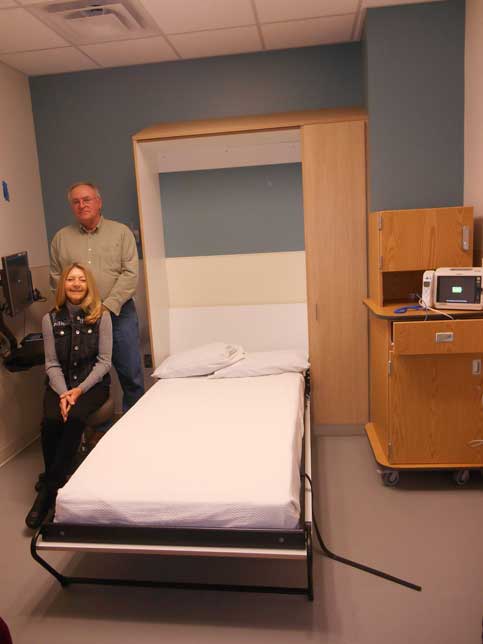 Most everyone can agree: there is nothing better than a great night’s sleep. However, a poll by the National Sleep Foundation found that 60% of Americans said they experience a sleep problem every night or almost every night. Sleep is as essential to our well-being as water and food, it affects memory, weight, your heart, physical performance, and more.
Most everyone can agree: there is nothing better than a great night’s sleep. However, a poll by the National Sleep Foundation found that 60% of Americans said they experience a sleep problem every night or almost every night. Sleep is as essential to our well-being as water and food, it affects memory, weight, your heart, physical performance, and more.
Uncovering the Issues
Sleep issues were common around the George and Pam Oltmans’ residence, until they decided to do something about it. Both George and Pam have had sleep studies done, and both wear a CPAP (continuous positive airway pressure) devise to bed at night. “George would notice I would stop breathing when I slept, which was news to me because I felt like I slept soundly”, Pam commented on the reason for her initial doctor visit with her local physician, Dr. Dynes. Pam continued, “When I spoke to Dr. Dynes about my symptoms, he recommended I get a sleep study done, which I did right here at the Windom Area Hospital”.
George and Pam’s oldest daughter, Jenny, who is a Registered Nurse, was the first to notice George’s breathing issues when he would nap. He would also feel ‘anxious’ after waking up at night, and would have problems getting back to sleep. George also had an initial sleep study done at WAH, but ended up having a 2nd study and CPAP fitting done at the VA in Sioux Falls.
Sleep Studies 101
Pam actually had two sleep studies completed as well, which is not uncommon in order to study one night’s sleep naturally, and one night’s sleep with a CPAP. The process for sleep studies includes:
- Initial exam and referral by a physician
- Schedule sleep study locally at Windom Area Hospital
- Arrive at the hospital in the late evening, abstaining from alcohol, caffeine and naps for periods prior to the study
- Bring pajamas and other night time rituals (books and TV are allowed)
- A sleep technician will be assigned to the study; electrodes are placed on the body and scalp to monitor sleep
- The technician will monitor the patient through the night with the study concluding between 5:00 – 6:00am
- Results are sent to the referring physician
- Abnormal results may result in further testing, a CPAP or other treatment
Pam recalls her experience, “I arrived at 9:00 p.m. and I had a very nice technician from SomniTech. She put electrodes on me, which took some getting used to. I was allowed to read a book and watch TV, it was very relaxing and I didn’t have problems falling asleep and felt like I slept well.”
However, Pam’s results showed some heart arrhythmias, so the doctor ordered another sleep study, in which the CPAP was used during the night. The 2nd study showed frequent, abnormal respirations. The result was a diagnosis of mild sleep apnea, but enough to warrant the use of a CPAP on a nightly basis.
George’s process was a bit different, with an initial study performed at WAH with a CPAP prescribed. “I never got used to it, quite frankly. I was going to the VA and decided to have a follow-up study done there, and I was fitted with a different CPAP.”
Surprises along the way
Being fairly new CPAP users, George and Pam found a few surprises as they were going through the process. George noted, “The VA told me they had issued 2,400 CPAP devices, just out of that location. I learned it is a very common problem.” In fact, 117 sleep studies have been conducted at the Windom Area Hospital alone in the last year. Of those, approximately 50% have resulted in CPAP as a treatment option.
Pam learned that each CPAP machine also has a data card, which you have to take to your medical equipment store to print results for your physician. Medicare sets specific guidelines for continued coverage of the equipment, including using it four or more hours on 70% of the nights during a 30 consecutive days, during the first three months of usage.
Life Saving Process
Both Pam and George commented that they’d recommend to anyone to get their sleep issues checked out. They both said, “If there is any indication that there is a problem, get it checked out. To stop breathing is a big deal, it’s life or death.” In fact, George’s physician at the VA described that his body waking him up at night and the anxiety he felt was a signal from his body that he was dying during those periods of respiratory distress.
In fact, obstructive sleep apnea (OSA) has shown to directly lead to the development of hypertension (high blood pressure) and increased chance of diabetes. More seriously, OSA increases the chances of a heart attack, stroke, or even sudden death.
Beyond the lifesaving aspects of the study and treatment, there are other worthwhile results. George noted that he feels very rested when he wakes most mornings, which was not always the case. Pam chuckled and added, “I think that’s partially because I’m sleeping better, and quieter! But I also have had lower blood pressure since I started with my CPAP.”
George and Pam Oltmans have been residents of Windom for 42 years and have three grown children; Jenny, Emily and Jeff. Pam recently retired from WAH as a transcriptionist but continues to work on an ‘as needed’ basis, while George still actively farms in the Windom Area.
To find out more about sleep studies, ask your doctor or contact Amber Brown at SomniTech at (605) 362-6204.
Mark your calendar for February 6, 2018 for a Special Event Presentation on Sleep Disorder Breathing. Click here for more information on this event!
